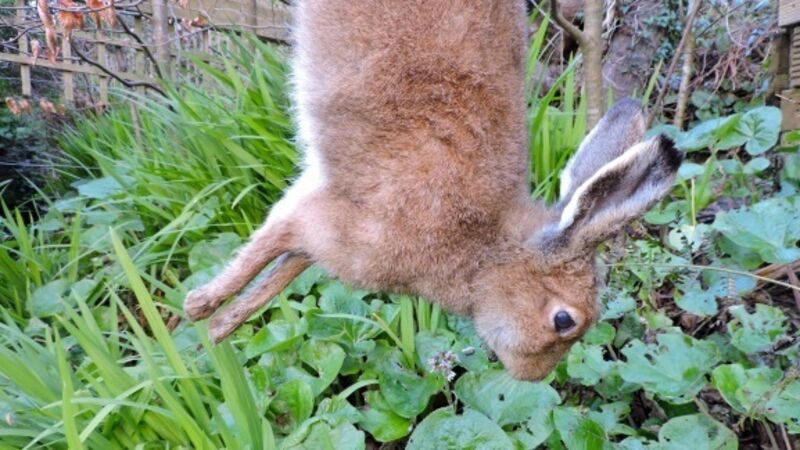A fine meal made from hare found on the road

It was cold night, and windy, rain driving against the windscreen. Nearing Timoleague, I spotted, between the beating wipers, a white scut of a tail attached to a russet body stretched on the verge and said to my wife “That’s a hare!”
We were past it before we had time to think but as we plunged downhill toward the village, I suggested that, if it was a hare, and undamaged, it would make a great goodbye dinner for our son and wife, arriving from London to spend two nights with us before flying out of Cork to Canada, there to spend a year.
A mile later, I turned the car at a gate. Five minutes later, holding the body up to the headlights, I confirmed it was indeed a hare, with no damage or crushing, but with one long, graceful back leg broken off at the knee.
The shock alone probably killed it. The “timidus” in its Linnaean name, Lepus timidus hibernicus, may refer not only to the shyness of the species but to its vulnerability to shock.
I remember as a boy, my father shooting his .22 rifle at a rabbit an impossible distance away and being surprised when it fell over. When we went to it, we found it was a hare, but no wound was visible. Then, we saw a spot of blood on the edge of one ear, and the semi-circular track of the bullet. My father didn’t shoot hares but, as with my road-kill, this one was dead anyway, so we took it home and my mother made hare soup.
My wife’s culinary plans were different. The last time we’d had road-kill hare, she’d casseroled it, and the meat had been delicious. Before taking our suitcases indoors, I went an hung it, head down, from a rafter in a cool shed. Two days later, jugged, with red wine added, it was delicious indeed, the dark, succulent, slightly gamey meat enough for four adults, and some left over. A fine, adieu dinner it made, and it was a useful finish for a beautiful creature.
Mountain hares are perhaps the oldest surviving species of indigenous Irish mammal. The brown hare, a newcomer, is found almost exclusively in the North.
Lepus timidus is found from Greenland through Europe, Russia, Mongolia and Japan to the Sakhalin Islands. Ours is a unique subspecies, not confined to mountains, and not turning white in winter as do other populations.
The animal I found was in perfect condition, its fur russet-red, eyes bright and shining, clean and beautiful, one leg broken by a car — no hope for a hare, with half a back leg snapped off. A male, it weighed 3.5kg; females weigh more. Females can produce three litters of four leverets per year and can gestate two litters at once, becoming pregnant again while carrying the first. They are tough animals, the lepus timidus. They are born out in the open, already fully furred, with eyes open. After just one week, they leave the scoop, returning once daily to suckle their mother, who goes to each leveret in turn.
They grow quickly on the highly nutrition milk and, fully weaned after three weeks, depart to find territory of their own. Many soon die, prey to foxes, stoats and raptors; the maximum lifespan of Irish hares is nine years.
Legally protected by the Irish Wildlife Act, the European Habitats directive, and the Berne Convention, hares may be hunted from late September to late February. Coursing is allowed using muzzled greyhounds, the hares used being tagged before later released to ensure they will not be coursed again.
Of our noble hare, we wasted nothing. Our visiting heron, now raising a family, happily gulped down the kidneys, liver and lights, a meal to be regurgitated for the fledglings.
We hear the same fledglings bickering in their treetop nest 20m above the forest path, with a view of the sea and of a rhododendron tree almost the same height, in flower. Giant rhododendrons are a feature (along with redwoods, live oak, myrtles and Chilean pines) of the old Earl of Shannon estate at Courtmacsherry. Happily, few rhododendron seedlings have succeeded, probably because the large beeches and Scots pines cut off the light. As long as the invader doesn’t spread, its flowers are, of course, delightful.
The finest rhododendron of all towers above the estate gate lodge. It is truly magnificent.














